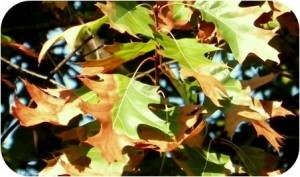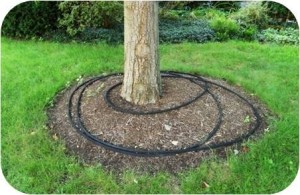Under ideal growing conditions, a tree’s root system can spread 2 – 3 times wider than the canopy. Roots will grow where there is adequate moisture and oxygen and, as a result, most of the fine absorbing roots are located in the upper 12 inches of soil.
Water Slowly and Deeply
We should apply water slowly so it has an opportunity to moisten the soil to a depth of at least 12”. Also, water should be applied to many locations under the drip line (the edge of the canopy). Watering frequently for only a few minutes at a time will encourage shallow root development which can actually cause more stress during a drought.
Watering Methods
Water is the single most important environmental requirement for a newly-planted tree. In order to get established in your landscape, a young tree needs at least 1” of water per week either by rain or manual methods. Larger, established trees require 1 – 3 inches of water per week. Be sure to check local weekly weather summaries. If we enter an extended period of below average rainfall, consider providing supplemental irrigation for your trees and shrubs.
- Tip: 5 gallons of water per square yard of surface area equals approximately 1 inch of water.
- Tip: Here’s a relatively cheap and easy drip watering method: Drill several ¼” holes in the bottom of a 5-gallon bucket, place it near the trunk, and fill it with water. For larger trees, use several buckets under the drip line.
Other watering methods include a soaker hose, drip irrigation, watering bags, soft spray wand, deep root fork, or deep root needle. If a deep root fork or needle is used, do not insert the device any deeper than 8 inches into the soil.
- Do not over-water your trees. Too much water can cause as much stress as long-term drought, especially if your trees are growing in heavy, poorly-drained clay soil. If the soil remains saturated, there will be much less oxygen available to support root respiration. This reduction in gas exchange causes severe stress that can predispose your tree to secondary diseases and insect pest infestations. For example, over-watered trees are very susceptible to root crown rot and Armillaria root rot. Stressed trees can also exhibit reduced root and shoot growth, and a noticeable decline in overall health.
How can we tell if we are overwatering our trees? Here are some signs:
- Soil is always damp
- Wilting, yellowing (chlorotic), and brittle leaves
- Algae and mushroom growth
Drought and Water Stress
During a typical year in the Lehigh Valley, we receive approximately 44 inches of rain. However, as we’ve learned all too often, we can receive record levels of rain one year but the following summer may be abnormally dry. During periods of drought, we should consider providing supplemental irrigation for our more valuable trees.
 Water stress can adversely impact most of the physiological processes involved in plant growth. The symptoms of drought stress may occur quite suddenly or may take several years to be noticed by homeowners. At first, we will often see some leaf wilt in the upper crown, followed by chlorosis (yellowing), browning, or scorching on leaf margins. During the early stages of water stress, conifers generally show yellowing and browning on needle tips.
Water stress can adversely impact most of the physiological processes involved in plant growth. The symptoms of drought stress may occur quite suddenly or may take several years to be noticed by homeowners. At first, we will often see some leaf wilt in the upper crown, followed by chlorosis (yellowing), browning, or scorching on leaf margins. During the early stages of water stress, conifers generally show yellowing and browning on needle tips.
As the drought continues, leaves can stop growing and appear much smaller than normal. Leaves may also begin showing signs of early fall color change, even dropping prematurely in midsummer. The leaves on some trees will stay attached but exhibit a brown or scorched appearance. Since wilting typically begins in the uppermost part of the canopy and progresses downward, drought-induced wilt and leaf drop can mimic vascular diseases like oak wilt or verticillium wilt. Severe water stress also interferes with photosynthetic processes resulting in reduced root, shoot, height, and diameter growth. Under long-term drought conditions, trees experience chronic stress and are vulnerable to secondary diseases and insect pests. Severely stressed trees attacked by these secondary pests rarely survive.
During a prolonged drought, communities may implement outdoor watering restrictions. In this case, consider giving your trees a higher watering priority than your lawn. Remember, turf will go dormant during a drought and can be replaced in a few months. It will take 20 years to replace a 20-year-old tree!
Do not fertilize trees that are under drought stress. The salts in fertilizers can burn roots growing in dry soil. Also, the nitrogen may encourage excessive canopy growth that can’t be supported by a drought-stressed root system.
Watering recommendations during drought (Drought and the Landscape – Penn State Extension)
- Newly-planted trees: 1 – 2 gallons per inch of trunk diameter. Watering 2 – 3 times per week for 8 – 10 weeks after planting should help the tree get established.
- Newly-planted shrubs and small container trees (1-3 gallon pot): 3 – 5 gallons of water 2 times per week.
- After the 8 – 10 week early establishment period: 1 gallon of water per square foot of surface area under the drip line, once per week. Remember, it may take 2 – 3 years for young trees to become fully established in the landscape.
Xeriscaping
Periods of drought provide us with an opportunity to appreciate our limited water resources and re-evaluate our landscape management practices. With the likelihood that we are facing a prolonged period of climatic variability, we should consider adopting a more sustainable landscape management technique called Xeriscaping. For more information, please check out the following resources:
Xeriscaping: Creative Landscaping (Colorado State University Extension)

